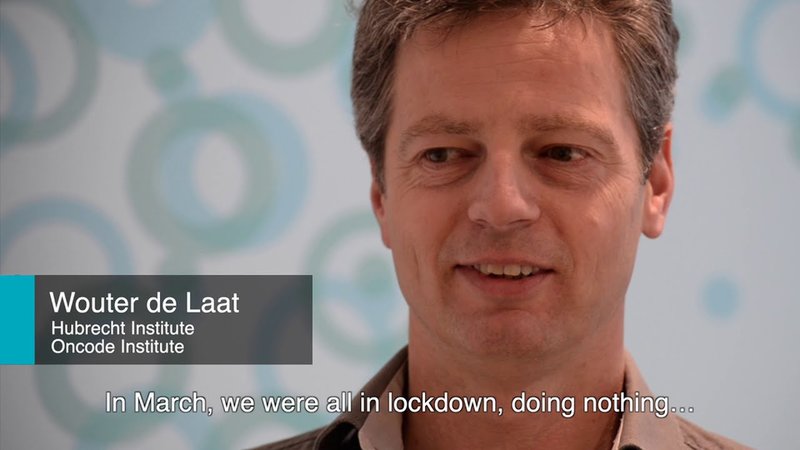#Eureka
What kept us busy these past months? Below you will read more about the progress we made on our way to outsmarting cancer and impacting lives. Read about new insights in colorectal cancer, a COVID-19 test robot, educational materials and more.
Zooming in on combination therapy in colorectal cancer
Since 2012 it is known that treating tumors with mutations in the KRAS/BRAF genes requires a combination therapy. But one question remained: why? The team of Oncode Investigator Hugo Snippert (UMC Utrecht) recently found the answer.
Read more...
Unique STRIP-1 test robot processes 20.000 COVID-19 tests a day
The game-changing Oncode-funded testing robot, co-invented and designed by Oncode Investigators Marvin Tanenbaum and Wouter de Laat (both Hubrecht Institute) in collaboration with specialists from the biotechnology company Genmab is now functional and installed in the medical-microbiology lab PAMM, in Veldhoven.
Read more...
Brief updates: Ammodo Award, patient engagement & a masterclass
What else happened over the past months? We wouldn’t want to withhold you the chance to take notice of some nice achievements of late.
Read more...
Read up on grant writing, intellectual property and clinical research
To enable our researchers to crack the code of cancer, we are expanding their knowledge about topics which are relevant to research but may not lie within the day-to-day scope of work. Oncode’s Through different tools we offer researcher clear insights into different topics.
Read more...

#Eureka
Zooming in on combination therapy in colorectal cancer
Since 2012 it is known that treating tumors with mutations in the KRAS/BRAF genes requires a combination therapy. But one question remained: why? The team of Oncode Investigator Hugo Snippert (UMC Utrecht) recently found the answer. Using organoid technology they were able to monitor live how a colon tumor responds to a combination therapy. The results appeared in the leading journal Nature Cell Biology and they offer many leads for follow-up research. And that is needed: colorectal cancer kills more than 4,800 people in the Netherlands each year.
Smart combination
So, let’s dig into it a bit more. Almost ten years ago, Oncode Investigator Rene Bernards (NKI) showed for the first time that inhibiting multiple components of cellular signaling pathways is necessary for effective treatment of this type of tumor. However, until now it was still unclear at the molecular level why this combination therapy is necessary. With organoid technology developed in the lab of Oncode Investigator Hans Clevers (Hubrecht Institute), mini-tumors have been grown from patient material in which the effect of drugs on the behavior of tumor cells can be measured using new methods. This has made it possible to very precisely measure the activity of the signaling pathways by which the cells communicate with each other.
"We knew that these types of tumors mainly respond to a combination of drugs, but not exactly why," Hugo explains. "With our Oncode base funding, we were able to invest in developing a very sensitive and precise measurement system: a microscopic technique that allows us to zoom in on individual cells and also to film over time how well these cells respond to treatments." Using the mini-tumors, the team found that inhibiting signaling pathways in cells did not happen with a single therapy, but required a combination. "This is because we need to dampen these signaling pathways much harder than thought and that we could measure before. Thanks to our precise measurement method, we now understand that there is a self-reinforcing mechanism in the signaling pathway, and that you therefore have to push more than one button to sufficiently inhibit the sometimes complex signaling pathways to fight the tumor," explains Bas Ponsioen, post-doctoral researcher in the lab of Hugo and the leading author of the paper.
Curious to read more? Find an extended article about this news on our website.
Photo credit: Joris Hageman
#Eureka
Read up on grant writing, intellectual property and clinical research
To enable our researchers to crack the code of cancer, we are expanding their knowledge about topics which are relevant to research but may not lie within the day-to-day scope of work. Oncode’s Through different tools we offer researcher clear insights into different topics. We recently added an Educational materials section to our website – which we aim to turn into a go to valuable and regularly updated source of information. Here are our most recent additions:
Create impact in funding proposals
Learn everything about how to convey impact when you are writing a grant proposal. Central questions in these tutorials include what ‘impact’ means in the context of funding proposals, is my approach to conveying impact effective and the how and what of Minto’s pyramid, You’ll find the answers with clear explanations and videos here.
Keeping information confidential
Privacy is important and a topic that has become more and more pressing in recent years. You may wonder what parts of your research you need to treat as confidential, and after reading this primer you will know everything confidentiality entails and why it is important and needed. This includes your obligations when sharing, receiving, or using confidential information. Do you know to which requirements – either from Oncode or from your institute - you might have to comply with? Read more in the introduction to confidentiality.
Video series: deep dive into the Clinical Proof of Concept landscape
To bring your invention to patients, you need to step into the realm of clinical research. But how? We have you covered. From the first introduction to pre-clinical requirements or the fundamentals of the development of a biomarker or biomarker assay. Or do you want to know more about Clinical Proof-of-Concept in Oncology? Or the Predictive value? Or perhaps how to define a Target Product Profile? This and much more is in this comprehensive video series, prepared by our OEDES team.
#Eureka
Unique STRIP-1 test robot processes 20.000 COVID-19 tests a day
The game-changing Oncode-funded testing robot, co-invented and designed by Oncode Investigators Marvin Tanenbaum and Wouter de Laat (both Hubrecht Institute) in collaboration with specialists from the biotechnology company Genmab is now functional and installed in the medical-microbiology lab PAMM, in Veldhoven.
Being able to test for COVID-19 easy and fast is vital, not only for identifying and isolating new cases, but also for setting life back on its rails to some degree, allowing people who have symptoms similar to those of the virus, but test negative to continue their life as usual.
At the beginning of the pandemic, Tanenbaum and de Laat noticed the problems with the amount and the logistics around doing PCR tests for COVID-19. What started as a desire to contribute something while being forced to stay at home, eventually became the STRIP-1 test robot.
Since the beginning of this year, the robot is ready to take on its mission, processing up to 20.000 tests per day, more than 30 times the amount processed in a regional centre for infectious diseases and pathology. Oncode played a pivotal role in quickly starting the acquisition of the robot through its technology and infrastructure funding programme. The Dutch government sees it as an innovative solution beyond the pandemic, eventually planning to install 5 of these systems across the country. In the video above, the two inventors explain more about the robot. You can also read more on our website.
#Eureka
Brief updates: Ammodo Award, patient engagement & a masterclass
What else happened over the past months? We wouldn’t want to withhold you the chance to take notice of some nice achievements of late.
Louis Vermeulen wins the prestigious Ammodo Science Award
Oncode Investigator Louis Vermeulen (Amsterdam UMC) studies how derailments in the genetic material of stem cells can cause colon cancer and focuses specifically on the earliest development of tumors. We are proud that this year he was one of eight outstanding young researchers to win the Ammodo Science Award. It is not only a prestigious recognition of his work, but it also brings 300.000 euros that he can use to further explore his ideas. Read more about what this award means for him.
Patients as inspiration for young talent
For many researchers, the patient sometimes feels far away. But in the end, the fate of today´s and tomorrow´s patients is a key driver of all our efforts to decode cancer. In March we got the opportunity to inspire the next generation of researchers: biomedical sciences students at the University of Utrecht. Two of our patient representatives and three of our researchers shared their personal experiences with the patient perspective programme. Read further about this unique online interaction.
Masterclass on single-cell (epi)genomics
Advances in single-cell technologies are providing unprecedented opportunities to analyze the complexities of biological systems at exceptional resolutions. Obviously, this holds many promises for cancer research. That’s why, Oncode Investigator Jop Kind (Hubrecht Institute) organized an Oncode Masterclass and familiarized attendees with the field of single-cell genomics/epigenomics and its applications, including a virtual tour of the new single cell epigenomics facility. Have a look at the event report for some more insights.

